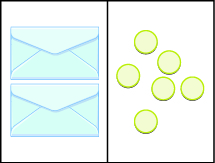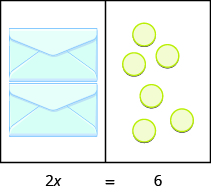| << Chapter < Page | Chapter >> Page > |
Before you get started, take this readiness quiz.
You may have noticed that all of the equations we have solved so far have been of the form or . We were able to isolate the variable by adding or subtracting the constant term on the side of the equation with the variable. Now we will see how to solve equations that have a variable multiplied by a constant and so will require division to isolate the variable.
Let’s look at our puzzle again with the envelopes and counters in [link] .

In the illustration there are two identical envelopes that contain the same number of counters. Remember, the left side of the workspace must equal the right side, but the counters on the left side are “hidden” in the envelopes. So how many counters are in each envelope?
How do we determine the number? We have to separate the counters on the right side into two groups of the same size to correspond with the two envelopes on the left side. The 6 counters divided into 2 equal groups gives 3 counters in each group (since ).
What equation models the situation shown in [link] ? There are two envelopes, and each contains counters. Together, the two envelopes must contain a total of 6 counters.

 | |
| If we divide both sides of the equation by 2, as we did with the envelopes and counters, |
 |
| we get: |
 |
We found that each envelope contains 3 counters. Does this check? We know , so it works! Three counters in each of two envelopes does equal six!
This example leads to the Division Property of Equality .
For any numbers a , b , and c , and ,
When you divide both sides of an equation by any non-zero number, you still have equality.
The goal in solving an equation is to ‘undo’ the operation on the variable. In the next example, the variable is multiplied by 5, so we will divide both sides by 5 to ‘undo’ the multiplication.
Solve:
| To isolate , “undo” the multiplication by 5. |
 | |
| Divide to ‘undo’ the multiplication. |
 | |
| Simplify. |
 | |
| Check: |
 |
|
| Substitute for |
 |
|
 |
||
| Since this is a true statement,
is the solution to . |
Consider the equation . We want to know what number divided by 4 gives 3. So to “undo” the division, we will need to multiply by 4. The Multiplication Property of Equality will allow us to do this. This property says that if we start with two equal quantities and multiply both by the same number, the results are equal.

Notification Switch
Would you like to follow the 'Elementary algebra' conversation and receive update notifications?